Lisbon, the capital of Portugal, is a city of seven hills, where beauty meets decadence, melancholic fado music echoes from the colorful buildings and the heritage of the discovery era gives way to the modern, multicultural city life.
Located on the shores of the Atlantic, Lisbon is one of the oldest cities of Europe and a diverse travel destination. There is something for everyone to be found in Lisbon, be it history, culture, food or beaches. The iconic trams and funiculars are a great help when exploring the hilly city, much of which can be reached by foot. The lush gardens of Lisbon, interesting day trip destinations and the beautiful sandy beaches that start right at the edge of the city create an extraordinary setting for a relaxing holiday.
Lisbon is a year-round destination, where the sun is warm even in the middle of the winter. The best time to visit Lisbon is from spring to autumn, but during the summer months the temperatures often rise up to 30 degrees and above. Luckily, the cooling breezes of the Atlantic are predominant in Lisbon and a refreshing dip in the ocean waves is never too far away.

The best neighborhoods to stay in Lisbon
The most central parts of Lisbon are Baixa and Chiado, which constitute the ‘downtown’ of the city, where a great part of the sights are merely a stone’s throw away. Metros, buses, trams and trains connect Baixa-Chiado with all directions and it’s also easy for taxis to drive in the area. Lisbon’s most important shopping streets with their boutiques and restaurants are located in Baixa-Chiado. The area is a good choice for those who enjoy the lively vibe of the city. Because of its relatively flat geography, Baixa-Chiado is also better suited for travelers with mobility challenges, in comparison to the more hilly parts of the city. The same is true for the districts of Avenida da Liberdade and Saldanha, a little further away from the main points of interest.
The oldest part of the city, Alfama, offers a more peaceful atmosphere. The neighborhood is known for its picturesque cobble stone alleys, where the melancholic rhythms of fado music are carried out of the windows of small coffee shops, children play street football and laundry dries outside of the pastel colored traditional buildings. Alfama has its fair share of uphills and downhills though, and the public transportation is sometimes a little far.

Bairro Alto is another central neighborhood of Lisbon, known for its bars and restaurants. It is well suited for those who enjoy vibrant nightlife. The blocks are quiet during the day, but fill up with party people especially on weekend nights, and the streets quiet down only after the bars close on the wee hours.
The peaceful residential neighborhoods of Graça, Príncipe Real, Madragoa/Santos and Estrela/Lapa are located slightly further from the downtown, but offer great accommodation choices for those who wish to live surrounded by local life yet staying in the inner city. The restaurant scene of Príncipe Real is worth experiencing, and the viewpoints of Graça offer breathtaking vistas above Lisbon, while the district of Lapa is known for its embassies.
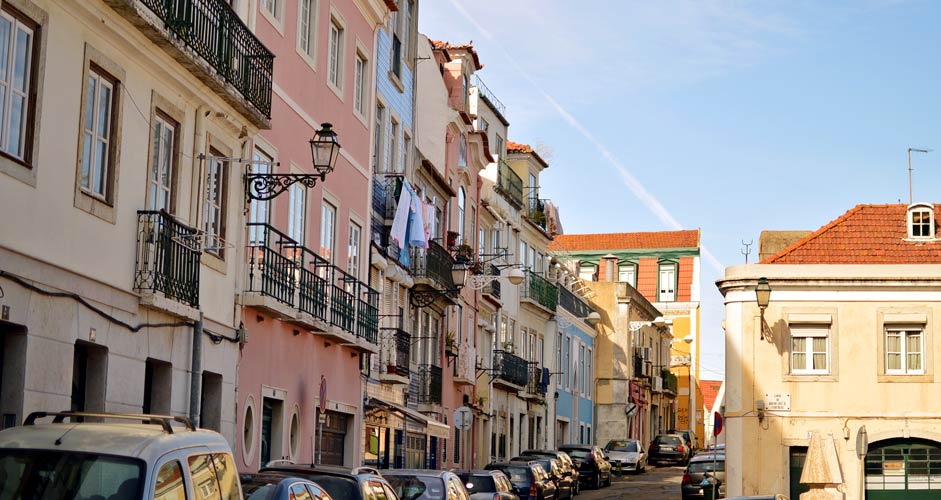
Lisbon is generally a safe city for tourists, but pickpockets are not uncommon, so it is advisable to look out for one’s belongings. It’s worth staying alert especially in the trams and close to the most touristic sights.
During the day, strolling anywhere in the center of Lisbon is safe. There are, however, some areas where walking around alone at night is not advisable, so to be sure, it might be wise not to stay in these areas either. The first is the Intendente district between the underground stations of Martim Moniz and Anjos. Also the streets directly next to the Cais do Sodré station may be a little restless at night time. In addition, walking in the parks alone in the dark is not advisable, and the same goes for some neighborhoods around the Monsanto forest park. However, when accompanied by a group, it’s usually all right to walk in these areas as well.
Lisbon charms with its diverse sights and activities
Lisbon is a versatile city destination that holds something for all tastes. The special light and many layers of the city, complemented by the panoramic views from hilltop miradouros, offer eye candy for a visual person. The historical sites, intriguing museums, colorful street art and lively event scene entertain those with passion for culture. A food traveler can indulge in the flavors of the Portuguese cuisine and tasting of the local wines. The gorgeous beaches, day trip destinations and green parks located in the immediate vicinity of Lisbon make also sunbathers and nature lovers immediately fall in love with this wonderful city.
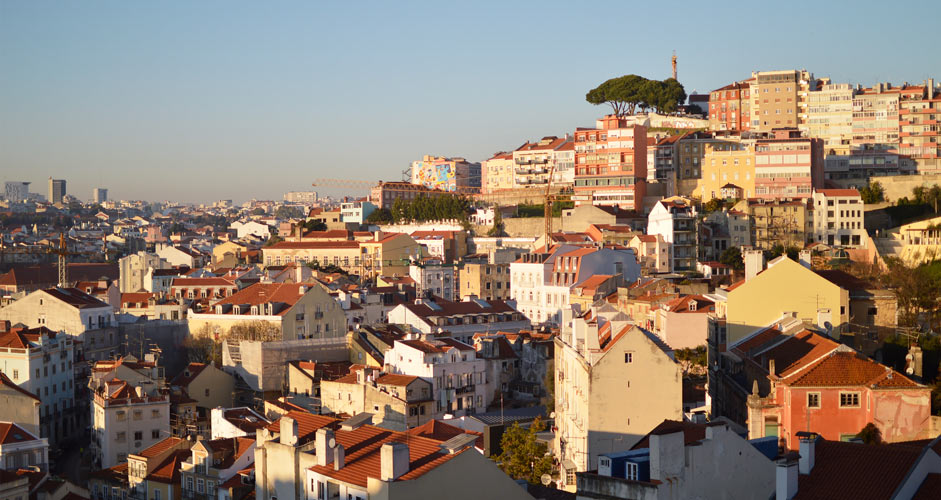
Baixa and Chiado
The square of Praça do Comércio, located in the middle of the downtown, Baixa, is a good place to start exploring the city. Many guided walking tours start from here. In the old days, a royal palace was standing on the square that opens up to the Tagus River, but it was destroyed in the disastrous earthquake of 1755. Because of this, the square is still called Terreiro do Paço, ‘the palace yard’. In the middle of the vast square stands the statue of King José I.
On Praça do Comércio, by the river, there is the pier of Cais das Colunas, equipped with stone posts. It was once the starting point for the discovery expeditions that changed history. Closer to Cais do Sodré stands a monument called Plantation – Prosperity and Nightmare – a memorial for the victims of the slave trade practiced by Portugal. Here one can learn more about the dark side of the discovery era.
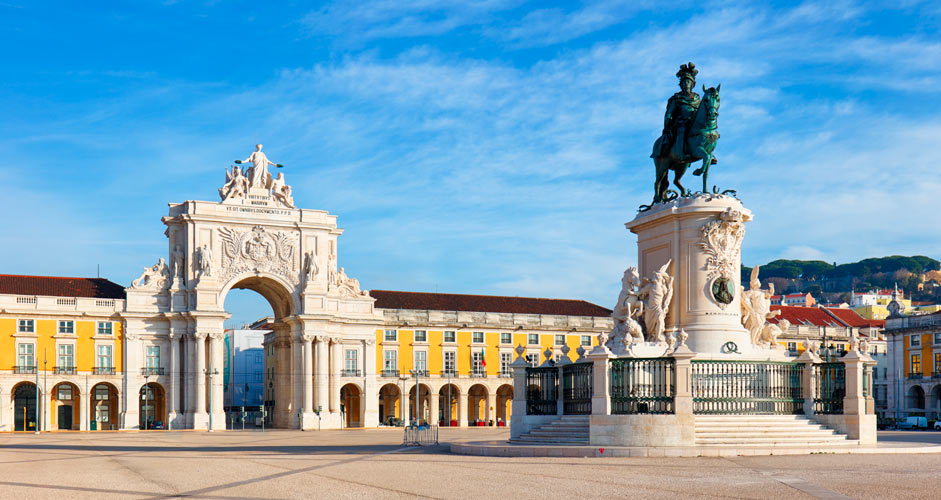
It’s good to start exploring the city center of Lisbon by heading on the pedestrian street of Rua da Augusta, below the detailed triumphal arc. Stores, restaurants, cafés, historical buildings and many street artists can be encountered while walking through the lively shopping streets. The oldest church of Lisbon, the Sé Cathedral, is also just a stone’s throw away.
Close to the Rossio square stands the Elevador de Santa Justa elevator, which was built in the beginning of the 20th century in order to ease the access from downtown up to the square of Largo do Carmo. The steel elevator has since transformed into a very touristic point of interest. On the Carmo square one can admire ruins of a medieval monastery, which was destroyed by the earthquake of 1755 as well. The convent’s cathedral was once the largest in Lisbon, and nowadays functions as an archeological museum.
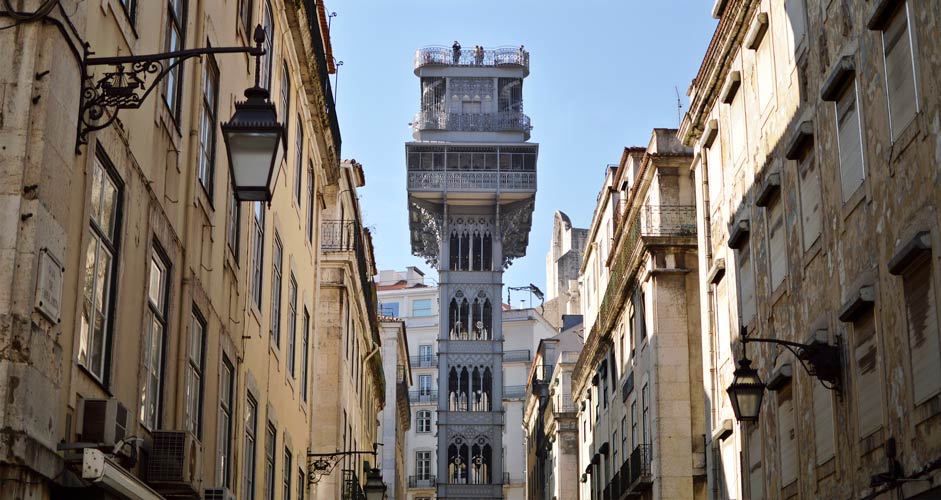
The squares
The Rossio square has been one of the main plazas of Lisbon since medieval times, acting as a setting for many events from uprisings to bull fights. Noteworthy details of Rossio include the gorgeous façade of the D. Maria II theatre, baroque style fountains and the Portuguese calçada pavements with flowing patterns. Rossio square is a home to many stylish cafeterias where Lisboners gather to meet each other.
Praça do Restauradores is the next square following Rossio, where one can admire an obelisk rising from the center of the plaza. The obelisk symbolizes the reconstruction of the independence of Portugal after 60 years spent under Spanish occupation. Many beautiful old buildings surround the square, the most interesting being the art deco style Cineteatro Éden. The funicular Glória takes travelers from Restauradores up to the neighborhood of Bairro Alto. The other iconic funiculars of Lisbon are called Lavra and Bica.
Restauradores is also the starting spot for the lush boulevard called Avenida da Liberdade, where boutiques of expensive luxury brands are located. The avenue leads to the square of Marques de Pombal, a busy business and transport hub named after the marquis who led the rebuilding of Lisbon after the 1755 earthquake.
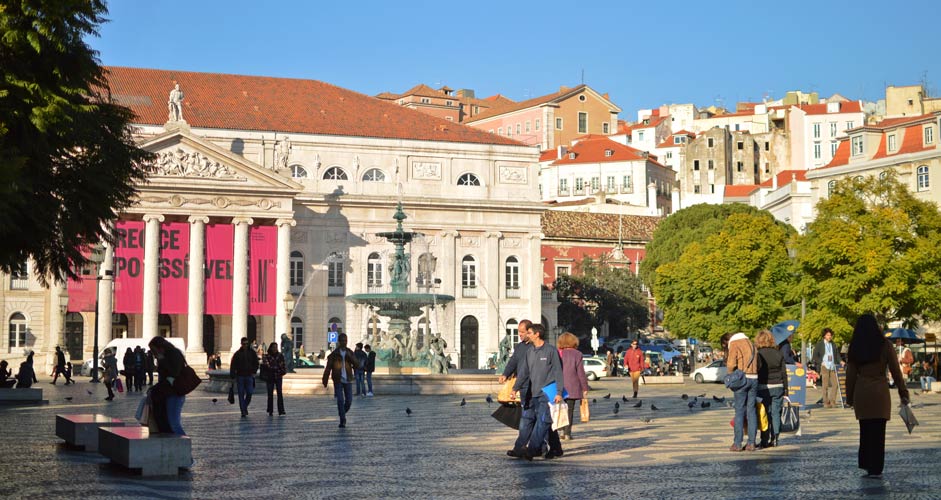
Alfama
The traditional neighborhood of Alfama is the oldest part of Lisbon, charming the visitors with its colorful houses and narrow cobble stone streets winding up and down the hills. The streets go all the way up to the São Jorge Castle. The castle itself is constituted mainly of the ruins of a medieval Moorish fortress, but the views from the castle walls are breathtaking. On the way to the castle one should lose themselves on the alleys further away from the busy main streets and peek into the traditional tasca eateries as well as small local shops. Many restaurants of Alfama offer live fado in the evenings. There is an escalator on the Praça do Martim Moniz square easing the climb up to Alfama.
In the vicinity of Alfama is the Santa Apolónia train station, the oldest train station of Lisbon, from where the domestic and international trains depart for example to Northern Portugal. Behind the station one can find the tile museum Museu Nacional do Azulejo, where it’s possible to admire the typical Portuguese tile art in an old convent. The landmarks of Alfama also include Panteão Nacional, the National Pantheon. It is a final resting place for multiple Portuguese celebrities, including the beloved fado singer Amália Rodrigues, the football player Eusébio as well as many presidents and authors.
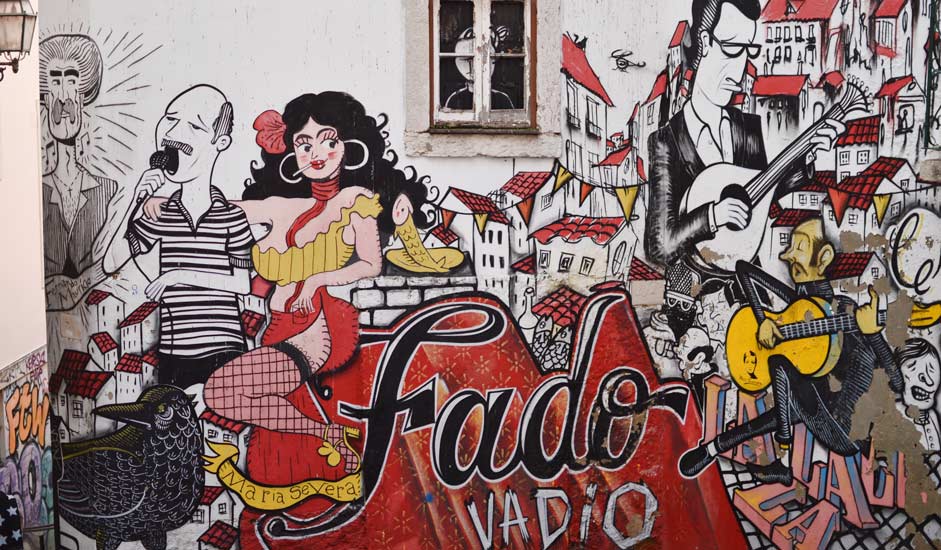
Viewpoints
Lisbon is known for its various viewpoints, miradouros, which provide different perspectives over the rooftops of the city. Miradouro da Nossa Senhora do Monte is probably the highest lookout of Lisbon, but Miradouro da Graça and Jardim do Torel are a bit more centrally located, featuring amazing panoramas over the sprawling city. Miradouro de São Pedro de Alcântara opens up towards the opposite direction. The viewpoints of Miradouro da Santa Luzia and Miradouro Portas do Sol feature beautiful views over the Tagus River, and are located in Alfama next to each other.
Many viewpoints have a bar kiosk and street artists are often seen playing live music. If one has the time, spending a whole summer evening enjoying the Lisbon viewpoint experience is well worth it!
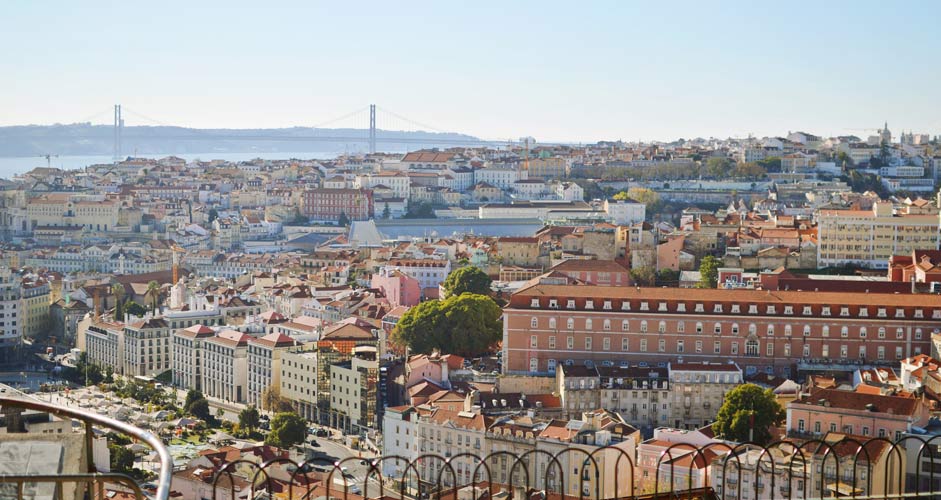
Belém
The Belém district is known for its many historical monuments, but also for sunny strolls along the Tagus River and the Belém dock, a starting point for river cruises on a sailboat. Some of the main sights of Belém include the majestic Jerónimos Monastery, historical Belém Tower and Padrão dos Descobrimentos, a monument erected in honor of the discovery expeditions but nowadays also questioned. The two latter ones are UNESCO World Heritage sites.
The architecture of the Jerónimos Monastery is a combination of gothic and manueline styles, and all the detailed ornaments of the building make it a very impressive sight. The enormous monastery was being built for the best part of the 16th century. The Portuguese explorer Vasco da Gama and the national poet Luís de Camões, known for the epic Os Lusíadas, are buried in the tombs of the main chapel of the monastery. The monastery is also the final resting place for the author Fernando Pessoa.
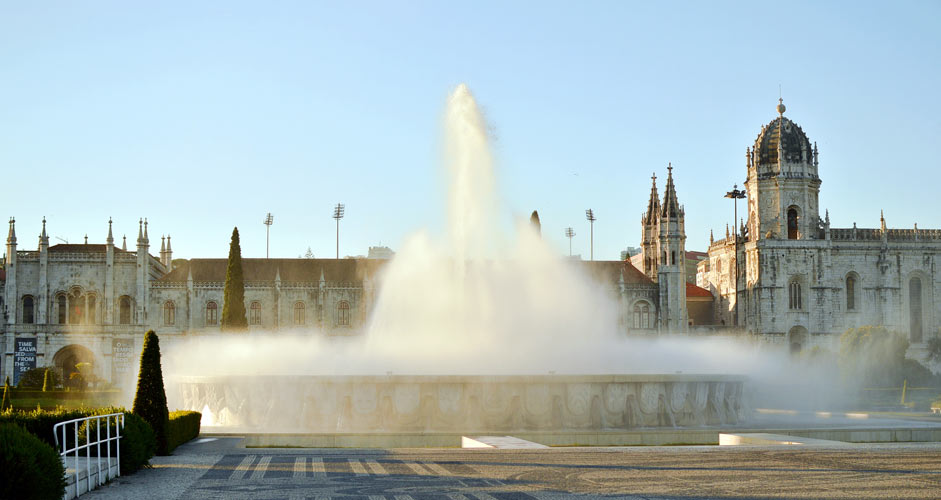
The Tower of Belém was built in the 16th century to honor the explorers departing to and returning from their voyages. This important landmark of Lisbon has also served as a lighthouse and a prison.
Those who enjoy art and technology should visit the futuristic-looking MAAT – The Museum of Art, Architecture and Technology in Belém. The bicycle roads following the river call for renting a bike and getting to know the sights of Belém by pedaling.

Parque das Nações
The relatively new Parque das Nações is a city part that was built for the World Exhibiton of 1998. It features modern architecture, futuristic street art and the bridge Ponte Vasco da Gama, which was the longest of Europe when it was opened. The green parks invite visitors to enjoy the charm of the riverside. The popular oceanarium of Lisbon, many restaurants, the science museum Pavilhão do Conhecimento, the shopping centre Vasco da Gama and a cable car running high up over the river are some of the activities in the area.
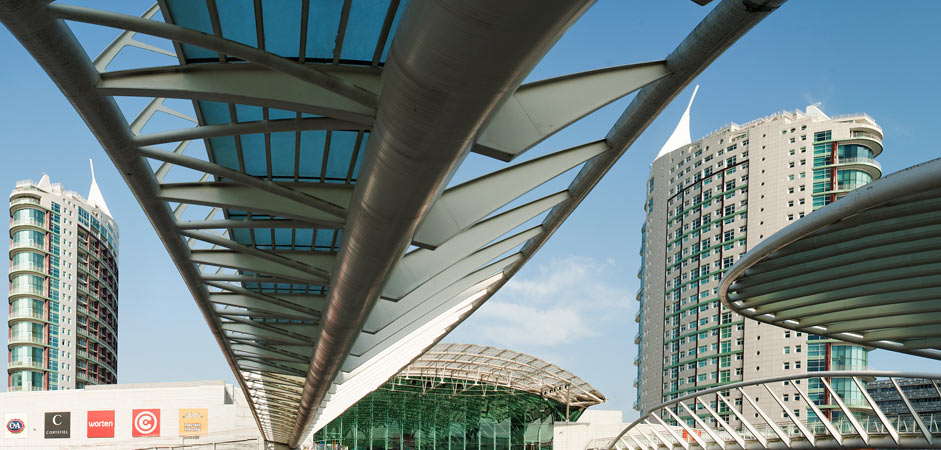
Almada
The city of Almada is located on the south bank of the Tagus River, offering a different perspective to Lisbon. The ferries over the river to Cacilhas leave from the ferry terminal of Cais do Sodré on the Lisbon side. The journey takes some 10 minutes.
In Cacilhas one can admire the decadent beauty of the derelict industrial buildings covered with graffiti art, and of course the views towards the opposite shore. The restaurants located by the river are a great choice for sipping sundowners while watching the sun disappear behind the 25 de Abril bridge. The panoramic elevator takes visitors up to the old town of Almada, although the most spectacular views can be found from the top of the Cristo Rei statue.

Lisbon is a city of lush parks and gardens
Fundação Calouste Gulbenkian
Fundação Calouste Gulbenkian is the place to go to when fancying the combination of art with a leisurely stroll in a park. The museum features the largest collection of modern art of the country, and the lush garden has several hideaway spots, from where to watch the birds, tortoises and other visitors of the park amongst the bamboo jungles. The grey concrete buildings of the foundation create a fascinating contrast with the abundant greenery.
The Botanical Garden of Lisbon
The walls of the Botanical Garden of Lisbon shut off all the hustle and bustle of the city, enfolding the visitor in a green oasis with an almost forgotten atmosphere. The swaying palm trees, pretty flowers and the light filtered by the tree canopies make sure one never wants to leave from here.
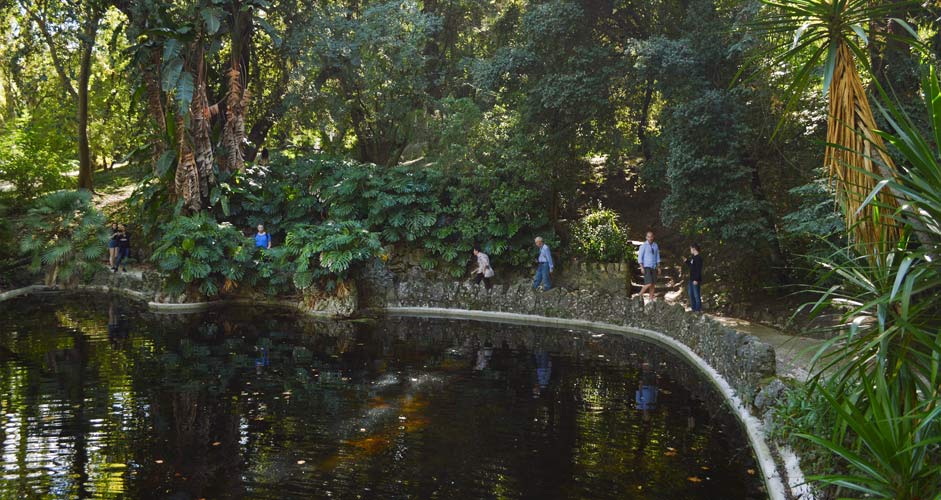
Jardim da Estrela
The Jardim da Estrela garden is located next to the shiny white Estrela Basilica and it is a common backyard of the area’s residents. People of all ages gather there to play, sit around on picnic blankets and watch the birds swimming in the ponds. The giant trees with hanging lianas and roots, fluffy palms and showy succulents such as agaves and cacti are the cherry on top of the cake. Events such as concerts and open air movies are also organized in the park.
Eduardo VII Park
The Eduardo VII Park consists mostly of lawn areas, the main attraction of the park being the view opening up over the city behind an enormous Portuguese flag flowing in the wind, lined by greenery. The park is also home to the Estufa Fria greenhouses, featuring three separate indoor gardens that constitute a hideaway with tropical vibe even on a rainy day.
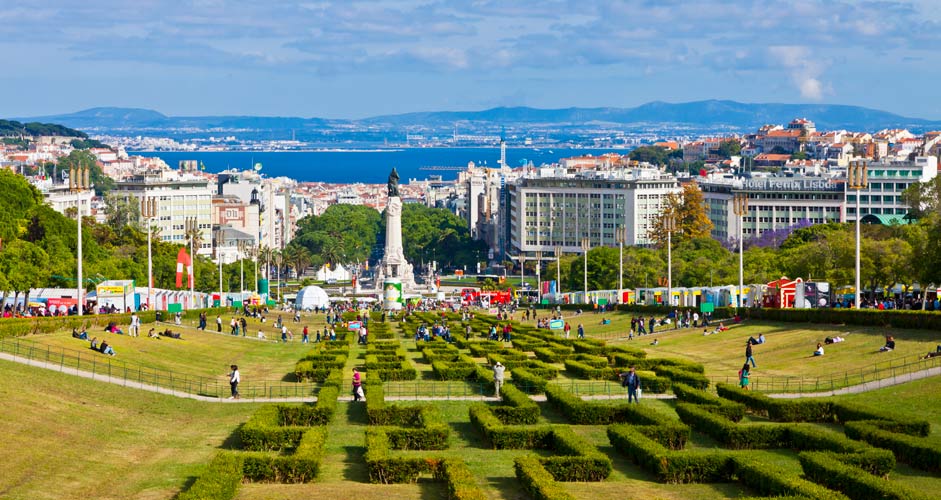
Cemitério dos Prazéres
The quiet cemetery of Cemitério dos Prazéres is a haven of peace in the middle of the city, but also a great spot for admiring the view over the 25 de Abril bridge. The detailed mausoleums decorated with silk flowers and threadbare curtains are built on neat alleyways amongst lines of cypress trees with cats napping in their shadows. The place manages to feed the imagination. One can take the famous tram number 28, equipped with wooden seats, all the way to the terminus of Prazeres. The other end of the tram line is in Graça and it connects the most important touristic areas of Lisbon. Because of their popularity, the cars of the clattering trams are often congested.
Monsanto
The forested central park of Lisbon, Monsanto, hides a network of jogging trails and play parks, but also an abandoned panoramic restaurant. The Panorâmico do Monsanto is decorated with graffiti art and features a 360 degree view over the entire city of Lisbon. By the Monsanto park there is a masterpiece of engineering work, the aqueduct of Águas Livres, that once transported large quantities of water to the city. Museu da Água is the starting point for a guided visit on top of the aqueduct.
Many gorgeous beaches are located just 30 minutes from Lisbon
Portugal is known for its amazing beaches, and also in the vicinity of Lisbon there are many of them, providing beautiful settings for a relaxing beach day. There is always a smaller or bigger breeze blowing from the Atlantic and the water is cool even during the summer, never exceeding 18-20 degrees, which is why many Lisboners head to the waterfront in the heat of the summer. The closest beaches to the city center can be accessed in half an hour by public transport.
Caxias and Paço de Arcos
The beaches of Caxias and Paço de Arcos lie west of Lisbon, and offer nice sandy stretches for sunbathing, swimming and surfing, even if the water is not the crystal clearest so close to the city. One can get to these beaches with the CP (Comboios de Portugal) suburban trains that stop on stations also named Caxias and Paço de Arcos. The train departures from the Cais do Sodré station towards Cascais.
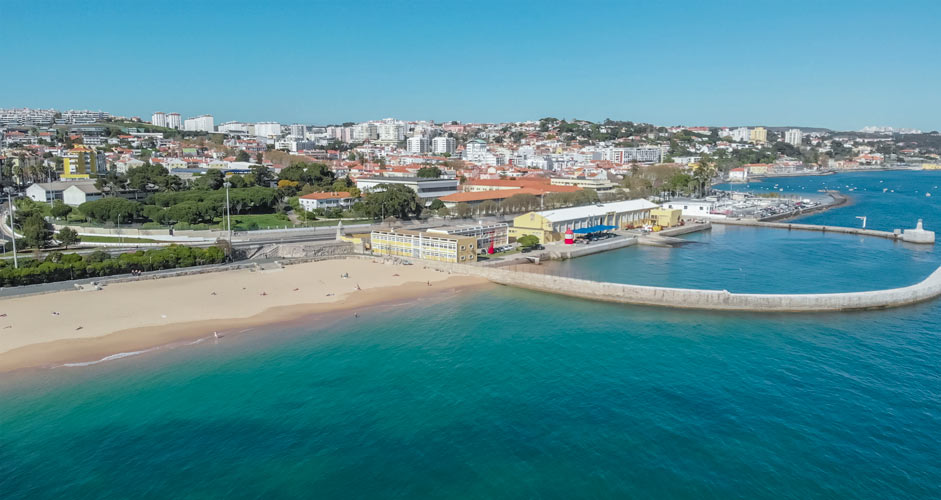
Costa da Caparica
On the southern side of the Tagus River lie the beaches of Caparica, also an excellent surfing destination. The Costa da Caparica is a 26 kilometer stretch of golden sand and waves of the Atlantic, lined by trendy beach bars and restaurants next to the town centers. The waves can sometimes be dangerous, so Caparica may not be the best beach for smaller children. Caparica is best accessed from Lisbon with the TST (Transportes Sul do Tejo) bus number 161, departing from Praça Areeiro and driving via Alcântara.
More beaches of the Greater Lisbon metropolitan area can be found in the Day trips section.
Lovely day trips to escape the city of Lisbon
Cascais and Estoril
The pretty holiday towns of Cascais and Estoril attract travelers on the western side of Lisbon. The old town of the upper-class Cascais is built around a lively marina, and is home to a good selection of restaurants, cafés and shops. There are several small but gorgeous beaches in the center of Cascais, for example Praia da Rainha. Larger beaches include Praia do Guincho, a vast beach popular among surfers and kite surfers, as well as Carcavelos, located closer to Lisbon.

The most fascinating point of interest of Cascais is Boca do Inferno, a sea cave of a kind, from which there are great views over the coastal cliffs. A bit outside of the center is the palacette of Casa da Guia, dotted with boutiques and restaurants with ocean views. There are also several museums and golf courses in Cascais.
Estoril is located right next to Cascais, and known for its casino and Hotel Palácio, a former setting of a James Bond movie. Also the F1 track Circuito do Estoril is one of the highlights of the town.
The suburban trains of CP travel to Cascais from Cais do Sodré station in Lisbon. The journey takes around 40 minutes and the train also stops on the Estoril station.
Sintra
Known for its fairytale palaces and castles, the cultural landscape of Sintra belongs to the list of UNESCO World Heritage sites. Various historical sites and a picturesque old town make Sintra perhaps the most popular day trip destination from Lisbon. The colorful Palace of Pena and the mystical Quinta da Regaleira with their enormous gardens are but two of the sights hidden on the slopes of the forested Sintra Mountains. Also the Moorish castle situated on a hilltop, the National Palace of Sintra and several other sites attract visitors in the town. When visiting Sintra, one should also try the queijadas de Sintra cupcakes.
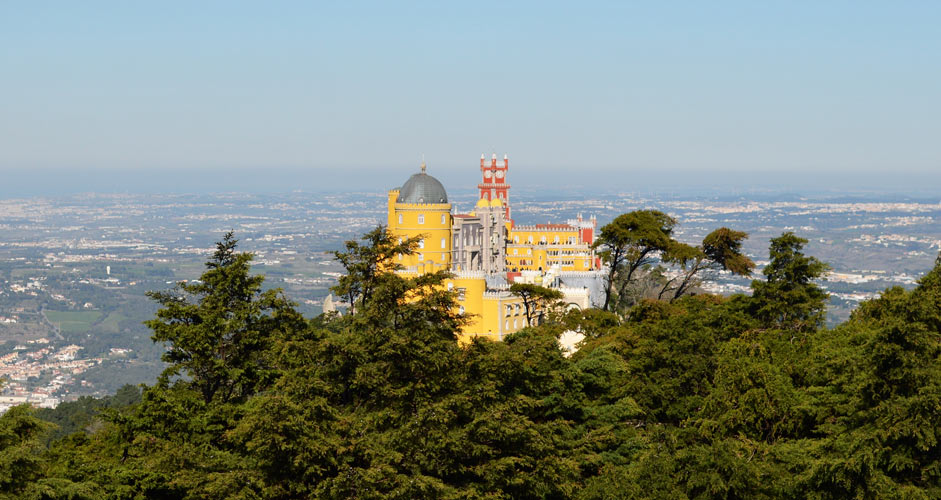
Cabo da Roca is the westernmost point of Portugal and continental Europe, located on the coast of Sintra. The coast around this windy cape is wild and beautiful, and there are many hiking paths around Cabo da Roca, one of which leads to the iconic Praia da Ursa beach. Also other beaches, including Praia da Adraga and Azenhas do Mar, are worth exploring. During summertime it’s possible to take the historical tram from Sintra to the Praia das Maçãs beach through amazing scenery.
Sintra can be reached by the CP suburban train, leaving from the Rossio train station in Lisbon. The journey takes around 40 minutes.
Ericeira
Ericeira is a world class surf destination located around 35 kilometers from Lisbon, and the only European destination granted the World Surfing Reserve status. However, the beaches of Ericeira are also great for sunbathing, which makes the town an excellent beach holiday destination too.
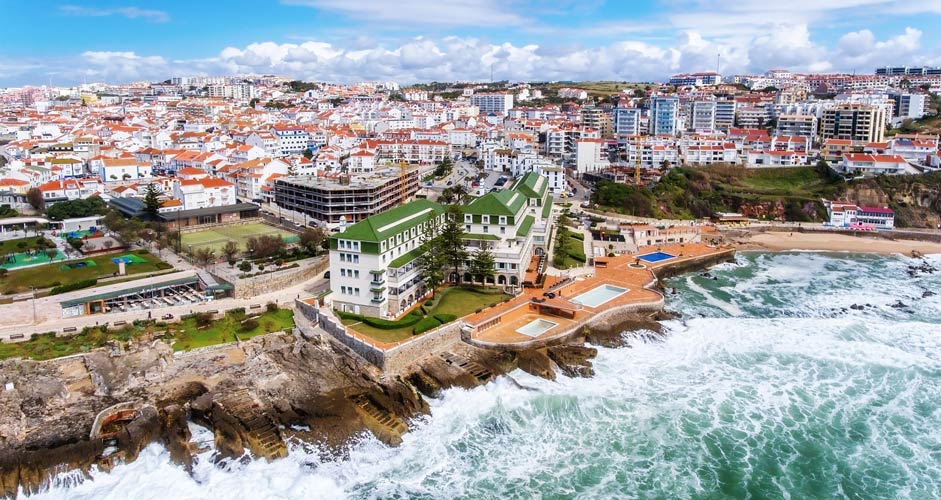
The atmosphere is tranquil when walking on the cobble stone streets among the white-washed buildings of the town centre. Being a traditional fishing village, Ericeira is a perfect place to try some locally caught fish, but the surfing community has also brought with them a taste of youthful nightlife and trendy cafés.
Ericeira can be reached from Lisbon by buses of the bus company Mafrense, which depart from the bus station of Campo Grande. The journey takes just over an hour. The day trip can be easily complemented by a stopover at Mafra, where the beautiful National Palace of Mafra can be admired.
Sesimbra
Sesimbra is a picturesque fishing village some 40 kilometers south of Lisbon. The postcard views enchant a visitor already before actually arriving in this town where history is still present. When in Sesimbra, one should definitely try some fresh seafood and fish grilled on coals.
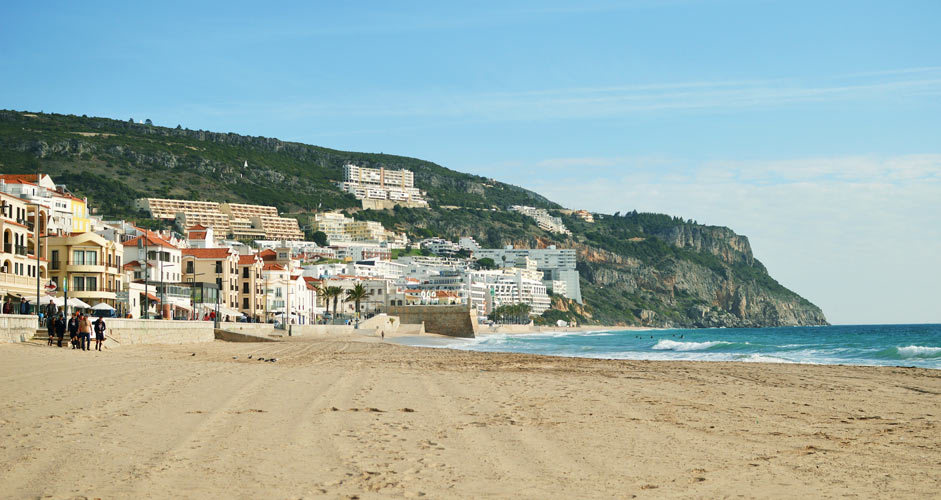
Sesimbra is known for its excellent fish and Carnival celebrations, but also for its beaches and water sports possibilities. Right at the center of the town there is a long and gorgeous sandy beach, and the coastline of Sesimbra is dotted with more paradise-like coves, one of them being Ribeira do Cavalo. On the western coast of Sesimbra, the beaches of Praia do Meco and Lagoa de Albufeira are a part of the long coast starting at Caparica. Lagoa de Albufeira boasts a calm lagoon in addition to the ocean beach, so it’s perfect for families with kids.
The cape of Cabo Espichel is an interesting old pilgrimage destination with its hermitages, sanctuaries and rugged views. On the cape it’s also possible to explore dinosaur footprints from close range.
The easiest way to get to Sesimbra from Lisbon is to take the TST bus number 207 from the Sete Rios station. The journey is approximately 75 minutes long.
Setúbal
The city of Setúbal lies in the Sado Estuary, about 50 kilometers south of Lisbon. The specialties of this industrial port city include a pretty old town, delicious seafood and the most amazing beaches of the Lisbon area. The special treat of the city is choco frito, fried cuttlefish. Starting from Setúbal, it’s possible to do a boat cruise watching the dolphins of Sado, or take a ferry to the white sand beaches of the Tróia peninsula. Tróia is also known for its resorts.
The western side of Setúbal is dominated by the Arrábida Natural Park, where the mountains of green, beaches of white and the sea of turquoise form one of the most astounding views of Portugal. Praia dos Galapinhos has been elected as the most beautiful beach of Europe, but also other beaches of Arrábida, such as Albarquel, Figueirinha, Gálapos and Creiro (Portinho da Arrábida) are close competitors. There are also many hiking trails in the Arrábida Mountains.
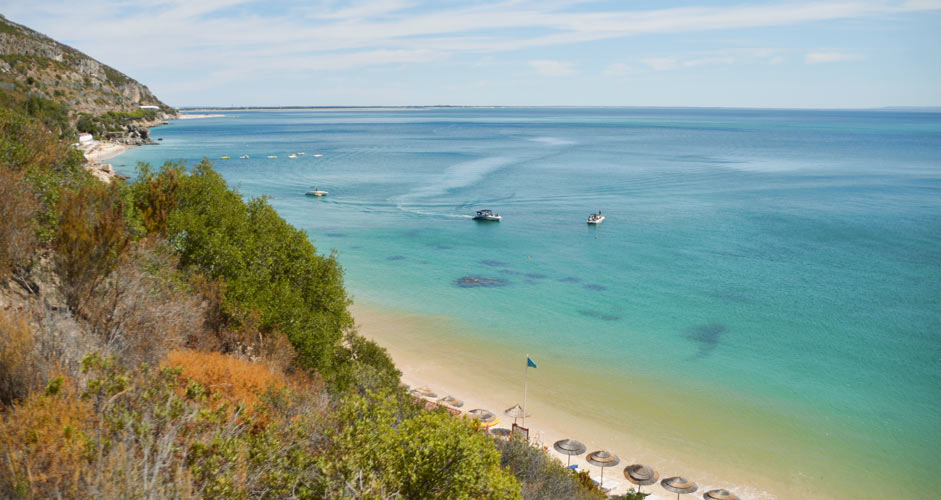
Setúbal can be reached by train of the Fertagus railway company, leaving from Roma-Areeiro station and stopping also at the stations of Entrecampos, Sete Rios and Campolide. The trip is around one hour long.
Also the sympathetic villages of Azeitão and Palmela situated close to Setúbal are worth visiting. Azeitão has several wineyards to explore and the views from the Palmela castle are breathtaking.
Tagus Estuary
If there have been enough beaches and cities for one trip already, it’s advisable to head to the Natural Reserve of the Tagus Estuary, a nature protection area of the Tagus River. The estuary is one of the most important wetland areas of Europe and a less visited day trip destination on the northern side of Lisbon. There, the reed beds of brackish water continue almost as far as the eye can see. Especially birdwatchers should visit the estuary, because many water birds overwinter in the area and in spring and fall the Tagus Estuary is busy with migratory birds, including pink flamingoes.
The visitor centre EVOA is organizing guided tours in the Tagus Estuary. The area is easiest to reach by taking the CP suburban train to Vila Franca de Xira and continuing onwards by taxi.
Portuguese food and international restaurants – Lisbon for culinarists
Lisbon is a food lover’s Mecca, having a vast selection of restaurants with flavors from cuisines all over the world to traditional Portuguese dishes and the most trendy brunch spots to be experienced. There are also a good number of vegetarian and vegan restaurants in the city.
Fish and seafood are an important part of the Portuguese cuisine, and these are a good choice to savor in Lisbon as well. The all-time favorites include fresh sardines barbequed in a coal grill, as well as dried and salted codfish bacalhau – an ingredient that can be found in one form or another on the menu of almost every single Portuguese restaurant.
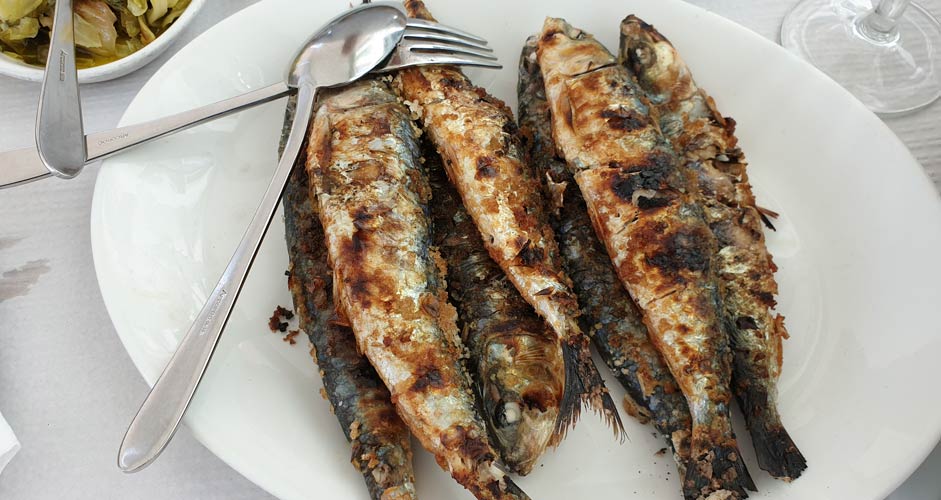
Different types of meat dishes are also the favorites of the Portuguese. To satiate a light hunger, one should try the Portuguese fast food favorite bifana, in all its simplicity a pork steak served in a fresh wheat bun. From the local sausages, at least chouriço and alheira should be sampled, while among the soups, the kale soup caldo verde is a classic. Petiscos – Portuguese tapas – are well worth savoring as well.
Many restaurants offer a daily lunch menu, normally including a soup, a main dish of fish or meat, a dessert, and coffee. The price is often less than 10 euros. The Time Out Market is an interesting place to eat at, because it collects dishes from the best chefs of the city under one roof. The large market hall is noisy, but the food is good. On the other hand, the most authentic restaurant finds of Lisbon are those small, local eateries located further away from the main streets, so a little detour is often well worth it when the hunger strikes.
Those who have a sweet tooth should remember the delicious pastel de nata cream custard tarts. According to the most common story, they have been invented in the neighborhood of Belém, where the Pastéis de Belém patisserie has made a reputation as the original maker of these pastries already for two centuries. The café is easily distinguished by the winding queue outside. However, the pasteis de nata coming straight from the oven of any bakery are absolutely mouth-watering.

A Brasileira is one of the oldest coffee shops of Lisbon, where the most well known authors of Portugal have been spending a good part of their time. On the outdoor patio, it’s possible to sit next to the statue of Fernando Pessoa while watching the passers-by and the ever present street artists. The cafeteria is located in Baixa-Chiado, on the square of Largo do Camões.
Drinking and nightlife in Lisbon
The Portuguese wines are delicious and often high quality. Especially the fresh whites, such as the mildly sparkling vinho verde, are a wonderful companion for fish and seafood dishes. Among beers, light lagers are the favorite of the Portuguese, the most known brands being Sagres and Super Bock.
From the drink selection, the sweet sangria and the limey caipirinha are popular among the locals. Ginginja, sold at small corner kiosks around Lisbon, is a tasty sour cherry liquor. On the Rossio square, a tiny bar called A Ginjinha has been serving this delicacy for almost two centuries. One should stop there to sip the sweet liquor from a chocolate cup.

The many rooftop bars of Lisbon are popular especially during the sunset hours, many of them offering amazing views over the city. Also the Santo Amaro marina has a nice restaurant area for a dinner or sundowners.
The nightlife of Lisbon is pretty lively. Bairro Alto is a traditional bar area popular among the youth, consisting of a few blocks of small bars serving drinks out, when the actual party is on the streets. Another bar street with a young vibe is located next to the Bica funicular. Those seeking alternative nightlife options should head to the Intendente area. The Pink Street in Cais do Sodré is known for its many nightclubs specializing in different music styles that remain open almost until morning. Many big clubs are located by the riverside. One of the most famous clubs of Lisbon is Lux, where international DJ’s and live artists make the party-goers dance all night to electronic music.
Lisbon hosts interesting events around the year
The Santos Populares festivities take place in Lisbon during almost the entire month of June. The streets fill up with people to celebrate Saint Anthony on the 12th of June. There are dance groups performing in a parade on Avenida da Liberdade while street parties occupy the colorfully decorated alleys of the traditional neighborhoods of Alfama, Mouraria and Graça. The scent of basil bushes and grilled sardines is strong in the air, the music is loud and wine glasses are being filled again and again. Later in the month Saint John and Saint Peter have their own celebrations as well.
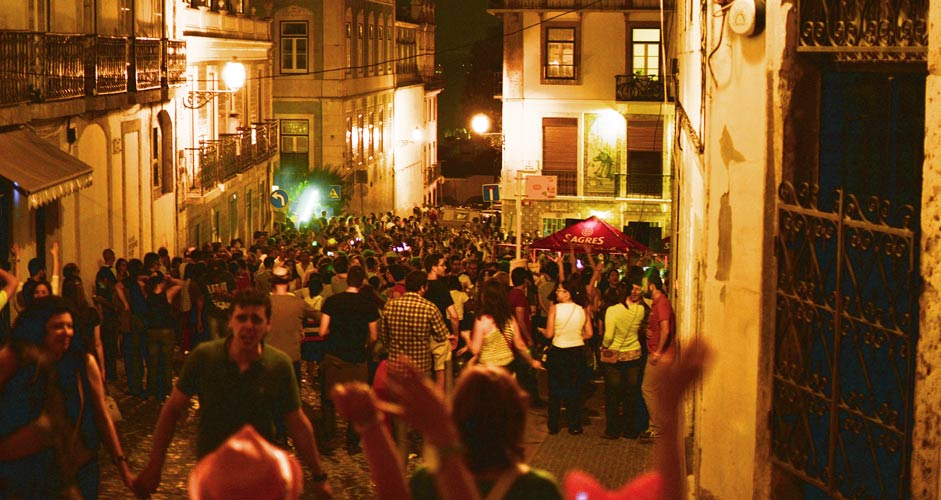
Before Christmas, Lisbon receives the Wonderland Lisboa theme park in the Eduardo VII Park, popular especially among families with children. Kids can have fun at the ferris wheel and the skating rink, while adults can make present finds in the shopping stalls and sample Christmas treats such as toasted chestnuts. Wonderland Lisboa is usually open from the end of November until the beginning of January. Also the beautiful Christmas lights of Avenida da Liberdade and Baixa-Chiado are well worth admiring.
During the Carnival season in February, it’s advisable to head outside of Lisbon to experience the festivities in either Torres Vedras or Sesimbra. The drum groups create the rhythms of samba, while the dancers dressed up in colorful costumes perform their carefully practiced shows.
Football fans can join the local supporters in order to watch the home games of the Benfica team at the Estádio de Luz stadium. Other big events in Lisbon are the New Year’s parties and the music festivals during summertime, including Rock in Rio, NOS Alive and Super Bock Super Rock.
The best shopping venues in Lisbon
The busiest shopping streets of Lisbon are Rua da Augusta and Rua Garrett, boasting a good selection of boutiques and chain stores, but also cafés where one can rest their feet in the middle of shopping sprees. The luxury brand stores can be found at Avenida da Liberdade.
The largest shopping mall of Lisbon and of the whole country is Colombo, accessible by taking the blue line of Lisbon metro until the station Colégio Militar/Luz. Located on the southern side of the river in Alcochete, the Freeport – Lisboa Fashion Outlet is a great place for discounted shopping with the favorite brands. There is a direct shuttle bus service from the Marquês de Pombal square. Other good shopping malls include Vasco da Gama, UBBO and Almada Forum.
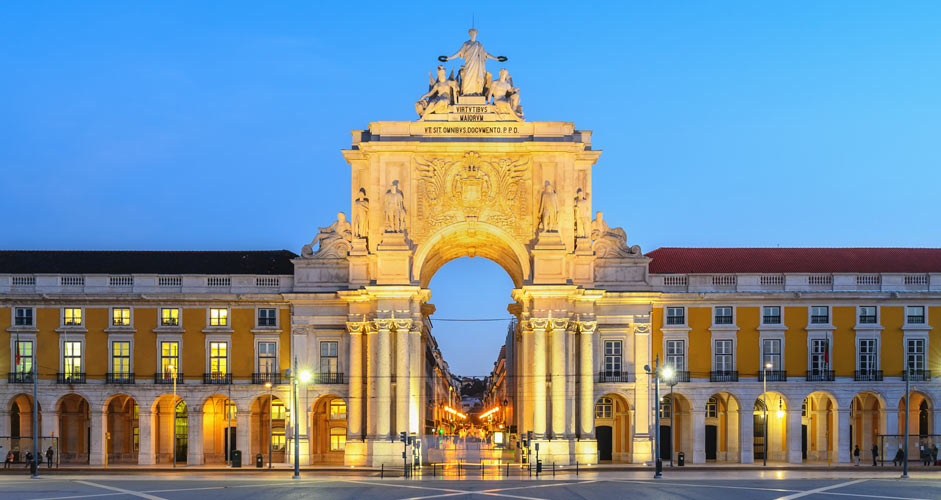
The flea market Feira da Ladra is a great place for shopping affordable souvenirs on Tuesday and Saturday mornings. This outdoor market is popular also among artists and hippie fare vendors, but unique finds are possible among the miscellaneous second hand goods. The address is Campo de Santa Clara.
In Alcântara, there is LX Factory, an urban meeting spot built in a former industrial area hosting a fair share of extraordinary boutiques and restaurants. Artisans and small businesses set up their stalls here during weekends. There are also all kinds of cultural activity going on in LX Factory from art exhibitions to concerts and festivals.
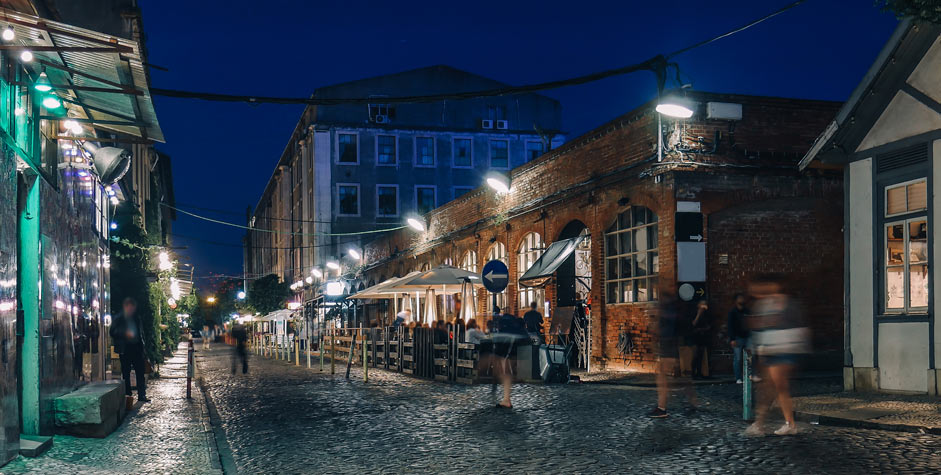
The best souvenir ideas from Lisbon include goods and accessories made of cork, azulejo tile art, local handicrafts such as pottery and ceramics or textiles, and products of local small businesses. Also Portuguese wines, olive oils and canned delicacies are great souvenir ideas.
Price range of Lisbon
Compared to other European capitals, Lisbon is an affordable travel destination. Especially dining and wining outside can be cheap, but there are options for every wallet. The tickets of public transportations are also easy on the pocket. However, the price of accommodation has been on the rise during the past years.
Fish meal
Steak meal
Lunch of the day
33 cl beer
€7-18
€8-20
€6-10
€1,50-3
How to get from Lisbon airport to city centre
The Lisbon city centre is easily accessed by metro from the Humberto Delgado airport. The airport is the terminus of the red metro line, the other end being in São Sebastião. In order to get to the downtown area, one must change the metro lines for example to the green line in the Alameda station, leaving towards Cais do Sodré.
Other transport options besides the metro include buses and taxis. The schedules and routes of the local buses are susceptible to change, so it’s advisable to hop on the Aerobus airport shuttle service. The buses drive directly for example to Rossio or Praça do Comércio and a one-way ticket costs a couple of euros. A taxi to the center of Lisbon costs around 15-20 euros, depending on the location of the hotel. Also the taxi apps such as Uber are handy in Lisbon.
The underground of Lisbon consists of just four lines, so it’s easy to navigate. Rechargeable cards are sold on the metro stations in the vending machines or ticket booths. If intending to use other transportation than the metro only, it’s advisable to charge the travel card with “zapping” instead of one-time tickets, a certain sum of money that can be used when traveling by any public transportation in Lisbon. During the busiest commuting hours, around 8-10 and 17-19, the means of transport are likely to be crowded.
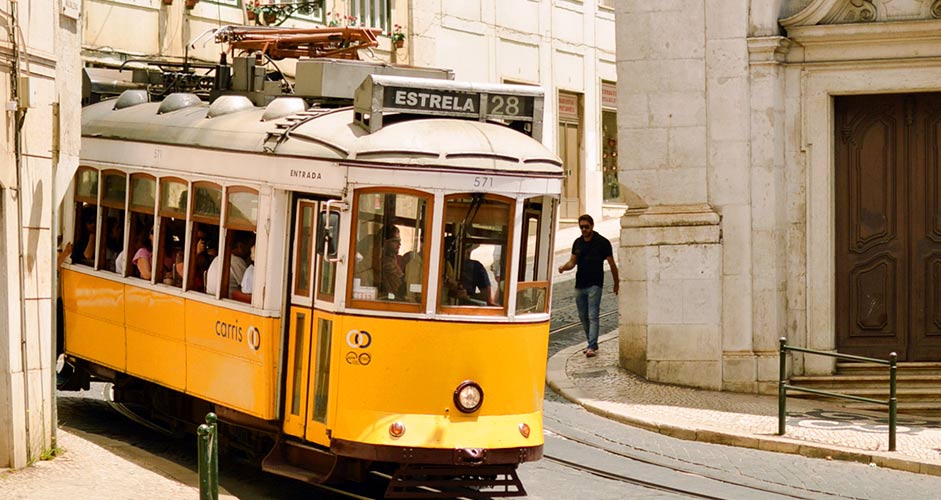
Weather in Lisbon
Lisbon is a year-round destination, whose climate is described by hot summers and mild, rainy winters. The city is at its best in the early summer in May-June, when the temperatures are nicely warm, the violet jacaranda trees are blooming and the busiest summer season has yet to be started. Another great time to visit Lisbon is in September and early October.
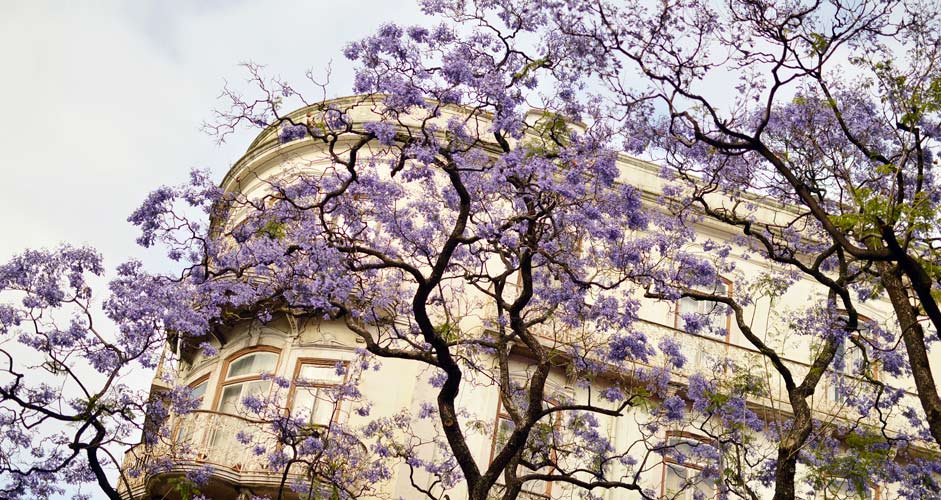
Winter: The mean temperatures of winter are around 11-12 degrees, the highest of the day being usually around 15 degrees. However, the sun is warm even in the middle of the winter. Many old buildings don’t have insulation, so if visiting Lisbon during the winter, it’s advisable to book an accommodation with heating or prepare oneself for chilly indoors. The rainiest time in Lisbon is from November to February.
Spring: The spring weather of Lisbon is often changeable. During the months of April and May the temperatures start rising on the better side of 20 degrees. Spring still gets its fair share of rains.
Summer: The mean temperatures are around 20-22 degrees in the summer. The daytime temperatures usually hover between 25-30 degrees, but heat waves soaring up to 40 degrees have become more common. The summers of Lisbon are typically dry and sunny, rains being rare. In July and August it can get sticky in the inner city because of high temperatures and the busiest tourist season.
Autumn: September is still practically a summer month, the heat beginning to lose its grip in October. From late October onwards the temperatures usually drop quickly on the chilly side and the winter rains start.
---
Text: Johanna Maldonado
Photos: Johanna Maldonado and Adobe Stock








